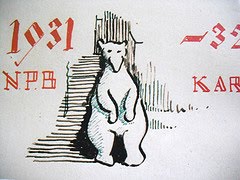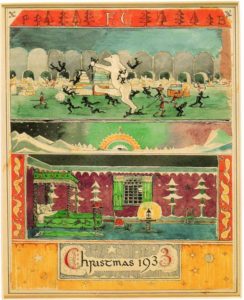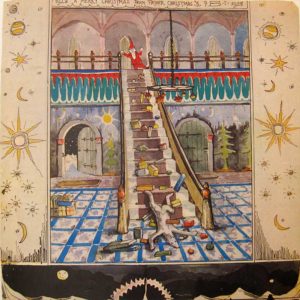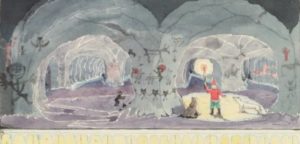Article by David Llewellyn Dodds

Tolkien’s illustration of North Polar Bear
In 1927, John Livingston Lowes published The Road to Xanadu: A Study in the Ways of the Imagination with a revised edition following in 1930. He traces the “caves of ice” in Coleridge’s “Kubla Khan” (lines 36, 47) to William Bartram’s Travels through North and South Carolina, Georgia, East and West Florida, the Cherokee Country, the Extensive Territories of the Muscogulges or Creek Confederacy, and the Country of the Chactaws. Containing an Account of the Soil and Natural Productions of Those Regions; Together with Observations on the Manners of the Indians (1791), by way of a note of Coleridge’s of “an Image of Ice” in “a cave in the mountains of Cashmere” (pp. 379-80).
 I do not know if Tolkien had read this, or was thinking of Coleridge, but in his 23 December 1932 letter to the Tolkien children, Father Nicholas Christmas recounts in his own shaky hand the adventures of his helper, the North Polar Bear (NPB), in “the caves (belonging to Mr Cave Bear, or so he says) not far from the ruins of my old house” (largely destroyed in 1925 when NPB brought the North Pole down on its dome, but ravaged further the following year when he messed with “the tap for turning on the Rory Bory Aylis fireworks” – “still in the cellar”, there – releasing “all the Northern Lights for two years in one go”). And he illustrates the letter (far from shakily) with reproductions of cave paintings there (not a little resembling renderings of more southerly ones by Abbé Henri Breuil), noting Cave Bear says “the bears first had the idea of decorating the walls, and used to scratch pictures on them on soft parts” – though later “Men came along”: “Cave Bear says there were lots about at one time, long ago, when the North Pole was somewhere else.” What astonishing eye-witness Polar revelations: caves in stone underneath the snow and ice of the North Pole. A Pole, if Ursine tradition can be trusted (for “That was long before my time, and I never heard old Grandfather Yule mention it even, so I don’t know if he is talking nonsense or not”), which was previously “somewhere else”.
I do not know if Tolkien had read this, or was thinking of Coleridge, but in his 23 December 1932 letter to the Tolkien children, Father Nicholas Christmas recounts in his own shaky hand the adventures of his helper, the North Polar Bear (NPB), in “the caves (belonging to Mr Cave Bear, or so he says) not far from the ruins of my old house” (largely destroyed in 1925 when NPB brought the North Pole down on its dome, but ravaged further the following year when he messed with “the tap for turning on the Rory Bory Aylis fireworks” – “still in the cellar”, there – releasing “all the Northern Lights for two years in one go”). And he illustrates the letter (far from shakily) with reproductions of cave paintings there (not a little resembling renderings of more southerly ones by Abbé Henri Breuil), noting Cave Bear says “the bears first had the idea of decorating the walls, and used to scratch pictures on them on soft parts” – though later “Men came along”: “Cave Bear says there were lots about at one time, long ago, when the North Pole was somewhere else.” What astonishing eye-witness Polar revelations: caves in stone underneath the snow and ice of the North Pole. A Pole, if Ursine tradition can be trusted (for “That was long before my time, and I never heard old Grandfather Yule mention it even, so I don’t know if he is talking nonsense or not”), which was previously “somewhere else”.
 In his delightful Tolkien at Exeter College (2014: p. 8), John Garth suggests that in 1911 the young Tolkien “may have enjoyed knowing that, nearly a century earlier the father of modern geology, Sir Charles Lyell, had also read classics at Exeter College.” Now, Lyell (as Garth may have been thinking), in 1872 had written, “Continents […] although permanent for whole geological epochs, shift their positions entirely in the course of ages”. And, as it happens, that recurring idea, already a controversial one for some 80 years, the idea to which Alfred Wegener had given the name ‘continental drift’, was just being championed again in 1931 by Professor Arthur Holmes of Durham University.
In his delightful Tolkien at Exeter College (2014: p. 8), John Garth suggests that in 1911 the young Tolkien “may have enjoyed knowing that, nearly a century earlier the father of modern geology, Sir Charles Lyell, had also read classics at Exeter College.” Now, Lyell (as Garth may have been thinking), in 1872 had written, “Continents […] although permanent for whole geological epochs, shift their positions entirely in the course of ages”. And, as it happens, that recurring idea, already a controversial one for some 80 years, the idea to which Alfred Wegener had given the name ‘continental drift’, was just being championed again in 1931 by Professor Arthur Holmes of Durham University.
Was Mr. Cave Bear espousing this, in his own way, just then, as well? Whether Men had added their paintings to the caves and these had then drifted north, or not, something perhaps relevant to that Polar bedrock had been publicly bruited about in years gone by. For, down the centuries, there are various witnesses that (as Hakluyt puts it in his translation of Gerard Mercator) “in the yeere 1360, a certain English Frier, a Franciscan, and a Mathematician of Oxford,” travelled to islands in the far North inhabited by descendants of people King Arthur had settled there, “and passing further by his Magicall Arte, described all those places that he sawe”, including the island at the North Pole, in a book now lost. Peter Heylyn notes that Oxonian’s report of an Arctic island “inhabited by Pygmies, the tallest of them not above four foot high”.
Now, we know how Tolkien later (Letter 239) told of abandoning the name ‘Gnomes’ in his work on Middle-earth “since it is quite impossible to dissociate the name from the popular associations of the Paracelsan gnomus = pygmaeus.” But, by 1932, Father Christmas had told the Tolkien children about the “Snow-elves” (1929) and now told them about “the Gnomes” including “the Red  Gnomes” already there “somewhere about Edward the Fourth’s time” (1461-70, 1471-83), Gnomes who are the “greatest enemies” of the “goblins”, whom they had helped clear out “about 1453” – with the letter’s envelope inscribed “By gnome-carrier”. Might Father Christmas be telling more about the true identity of these ‘pygmy’ northern Gnomes and the true nature of that solid Polar earth, seen by that old travelling Oxford scholar? The height of “some children of the Red Gnomes”, at least, is shown in a 1932 painting, though that of the Red Gnomes themselves (seeming equally – if not more – diminutive) must await 1933.
Gnomes” already there “somewhere about Edward the Fourth’s time” (1461-70, 1471-83), Gnomes who are the “greatest enemies” of the “goblins”, whom they had helped clear out “about 1453” – with the letter’s envelope inscribed “By gnome-carrier”. Might Father Christmas be telling more about the true identity of these ‘pygmy’ northern Gnomes and the true nature of that solid Polar earth, seen by that old travelling Oxford scholar? The height of “some children of the Red Gnomes”, at least, is shown in a 1932 painting, though that of the Red Gnomes themselves (seeming equally – if not more – diminutive) must await 1933.
Tolkien might have said of his Polar region in these letters something like what he later said of Middle-earth in The Lord of the Rings (Letter 187), “Having geological interests, and a very little knowledge, I have not wholly neglected this aspect, but its indication is rather more difficult – and perilous!” Whether he would have been rereading older Father Christmas letters as he worked on his 1936 one, and so have mysterious continents that much the more in mind, as “the Númenor idea arose between 5 and 8 December 1936, or in the days immediately following” (to quote John Garth), are intriguing questions.
Illustrations by Tolkien, from his Father Christmas letters.
Bibliographical Note
The Wikipedia articles, “Inventio Fortunata” and “Rupes Nigra” are interesting, here, not least for their illustrations and links, while B.F. De Costa offers a convenient (if in many ways startling) overview with quotations in Inventio Fortunata: Arctic exploration with an account of Nicholas of Lynn (New York, 1881), conveniently scanned in the Internet Archive. Edward Watson has a very interesting collection of posts at his blog, Clas Merdin: Tales for the Enchanted Island, gathered together under Arthur in the Arctic (linked at the top of its Home page).
The quotation from Charles Lyell is from Principles of Geology or The Modern Changes of the Earth and Its Inhabitants Considered as Illustrative of Geology (London: John Murray, 1872), p. 258 as scanned in the Internet Archive and linked in the Wikipedia article, “Continental drift”.
The quotation from Richard Hakluyt is from Principal Navigations, Voyages, Traffiques and Discoveries of the English Nation, ed. Edmund Goldsmid as transcribed on the University of Adelaide website. The quotation from Peter Heylyn is from Gosmographie [sic], The Fourth Book: Part II Containing the Chorography & Historie of America, And all the Principal Kingdoms, Provinces, Seas, and Islands of it (1656) as found in ‘microform’ in the Internet Archive.
The quotation in the last paragraph comes from John Garth, “When Tolkien reinvented Atlantis and Lewis went to Mars” (31 March 2017) on his website.
J.R.R. Tolkien, Letters from Father Christmas, ed. Baillie Tolkien (Hammersmith: HarperCollins, 2009 paperback ed. of 2004 revised ed.)
The Letters of J.R.R. Tolkien, selected and ed. Humphrey Carpenter with the assistance of Christopher Tolkien (Boston: Houghton Mifflin, 1981).



Thank you for this piece!
“the Rory Bory Aylis fireworks”, “old Grandfather Yule”, much to charm here. Then, ‘continental drift’ was evident to me as a child looking at giant world maps on the right hand wall in 1st grade, though no one had ever mentioned it. The continents fit like pieces of a puzzle, I thought.
such generosity, so much to like in JRRT’s creative engagement with art and his kids.
You’re welcome – and you’re right about his creative engagement! (And about the puzzle pieces – South America and Africa, particularly, I think.)
Baillie Tolkien has a delightful article for those who don’t know it, yet:
http://www.tolkienestate.com/en/writing/tales-for-children/letters-from-father-christmas.html
I don’t know if we would ever have gotten to see them, if he had only been the famous and influential scholar, and not the author of The Hobbit and then The Lord of the Rings as well, but I think they would be a joy and a great play with the lore and a classic, even if they were the only non-scholarly thing of his we knew.
I will check it out! Thanks!
thank you for the link and response. oh! nearly a quarter century worth of these letters and illustrations! again, amazing generosity. …and ah the lovely bit about Gandalf slightly suggested in the character of Father Christmas. but should i be surprised …as i was…?
It just struck me to wonder, in writing this, what the implications of “I never heard old Grandfather Yule mention it” might be – did Father Christmas simply not pause to ask him, before writing the letter, or should we be asking, ‘where is old Grandfather Yule?’ We know Fr. Nicholas’s Green Brother is still around, though not at the North Pole – and this comparison of Gandalf has me suddenly wondering if we could compare these three with the Council of Wizards, the Istari, in some respects, too?
That’s a really interesting question!
And now its got me thinking more broadly about wizards in Inklings works, not least comparative Merlins…
I had completely forgotten when writing this, about the young Tolkien having made a picture inspired by Coleridge’s poem, ‘Xanadu’, which is included in the “sketchbook he called The Book of Ishness” (which sketchbook I understand is in the exhibition, Tolkien: Maker of Middle-earth, which was at the Bodleian in one form and is now at the Morgan Library in New York in another):
http://www.tolkienestate.com/en/learning/tolkien-and-visual-arts/tolkiens-art.html
Finally catching up with Hugh Lofting’s The Voyages of Doctor Dolittle (1922), I wonder if Tolkien knew it – and knew how well the children knew it – for, in Book II, Chapter 11, “Blind Travel”, Doctor Dolittle quietly reveals (pp. 138-39), “I’ve been to the North Pole” and when his young assistant, Stubbins, asks him, “Why isn’t your name down if you discovered it?”, he reveals, “I promised to keep it a secret. And you must promise me never to tell any one. Yes, I discovered the North Pole in April, 1809. But shortly after I got there the polar bears came to me in a body and told me there was a great deal of coal there, buried beneath the snow. They knew, they said, that human beings would do anything, and go anywhere, to get coal. So would I please keep it a secret. Because once people began coming up there to start coal-mines, their beautiful white country would be spoiled – and there was nowhere else in the world cold enough for polar bears to be comfortable. So of course I had to promise them I would. Ah, well, it will be discovered again some day, by somebody else. But I want the polar bears to have their play-ground to themselves as long as possible. And I daresay it will be a good while yet – for it certainly is a fiendish place to get to”. Another presentation of land – and presumably a land once warm enough long ago for coal seams to form – beneath the Polar snow, and one inhabited by talking polar bears who know of its subterranean features – though if the book was known to all the Tolkiens, there must surely have been family discussions as to why Doctor Dolittle does not mention Father Nicholas Christmas and the Gnomes.
I quote from The Voyages of Doctor Dolittle (New York: Frederick A. Stokes, Fourteenth Printing, September 1, 1933) as conveniently both scanned in the Internaet Archive and transcribed at Project Gutenberg.
Reading John H. Bowers’ Tolkien’s Lost Chaucer (OUP, 2019), I find on page 133 in footnote 101 (of chapter 5) that for this Father Christmas letter, “Christopher recalled that his father relied upon M.C. Burkitt’s Prehistory: A Study of Early Cultures in Europe and the Mediterranean Basin (1925)” – with no further reference as to where Christopher Tolkien said this.
There are two scans of a 1921 CUP edition of this book – which has a Preface by L’Abbé H. Breuil – in the Internet Archive for the convenience of anyone wanting to follow this up.
Wow! Just encountered this linked at the New Advent Home Page:
https://siberiantimes.com/other/others/news/first-ever-preserved-grown-up-cave-bear-even-its-nose-is-intact-unearthed-on-the-arctic-island/
It makes me realize how inattentive I have been to the ‘cachet’ of the Cave Bear and family in these letters – in contrast to the Tolkien children?
But now I read:
https://www.livescience.com/prehistoric-mummified-bear-discovered-in-siberian-permafrost-isnt-what-we-thought
“The bear, unearthed in 2020, was originally assumed to be an extinct cave bear that dated back at least 22,000 years. But a new necropsy reveals it is actually a brown bear that lived 3,500 years ago.”
This, of course, in no way affects the ‘cachet’ of the Cave Bear and family in the letters – if the assumption in the 1930s, as in this article, was that Cave Bears “went extinct around 22,000 years ago, toward the end of the Last Glacial Maximum, the coldest part of the last ice age”.
One wonders how far Tolkien had worked out the interrelations of Númenórean Bears – revealed in The Nature of Middle-earth in a previously unpublished part of the text excerpted in Unfinished Tales – and known species, including Cave Bears.
Only about a year late in noting John Garth’s 24 December 2023 post at his blog – with a link to the full article, with lots about the Father Christmas letters and especially the 1932 one and M.C. Burkitt’s Prehistory: A Study of Early Cultures in Europe and the Mediterranean Basin (1925) – and a possible Hungarian connection to add to the variously -attested ones my Magyar-speaking co-author and I have published in Beyond Bree this year, and other possible ones not yet discussed in print!